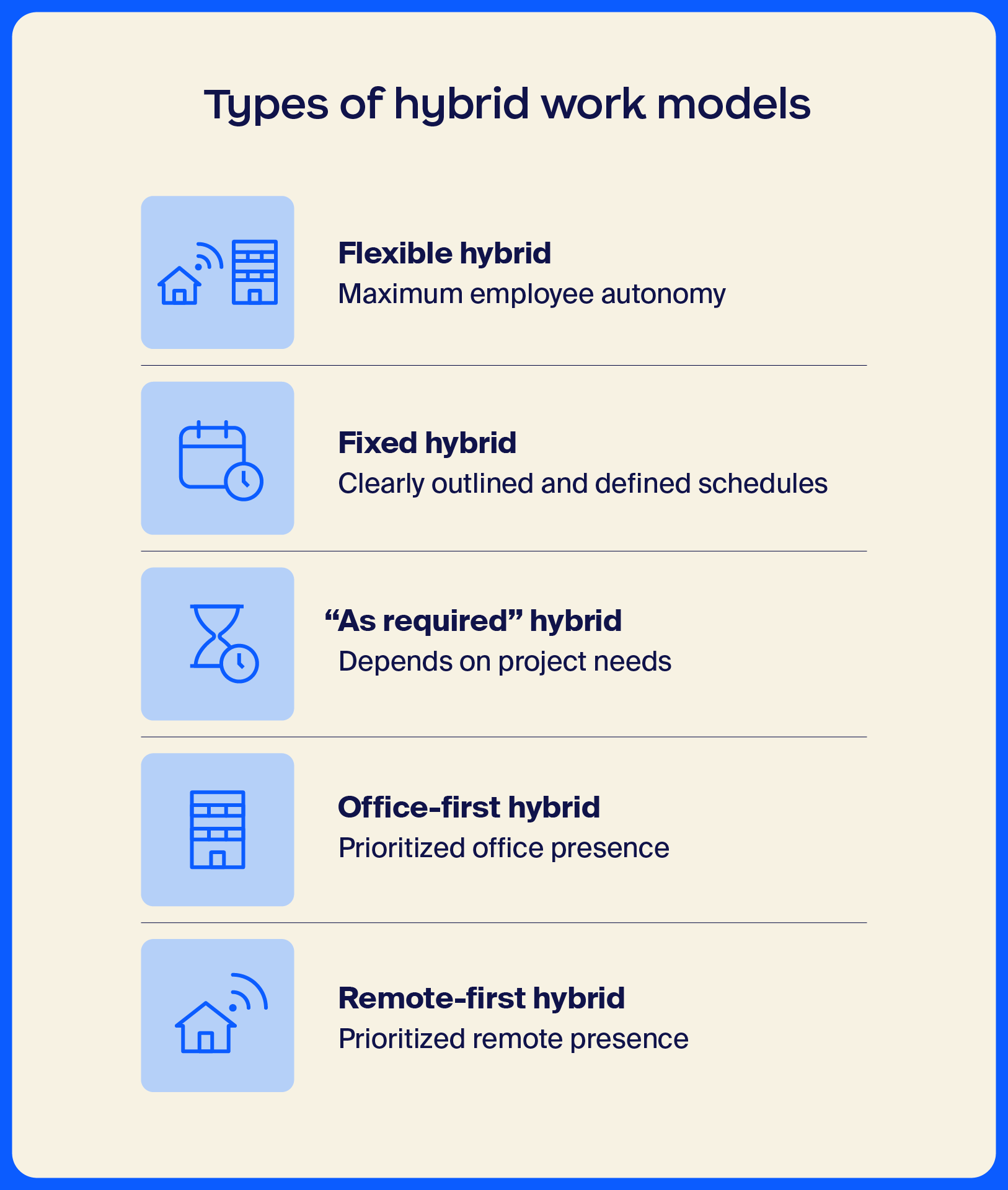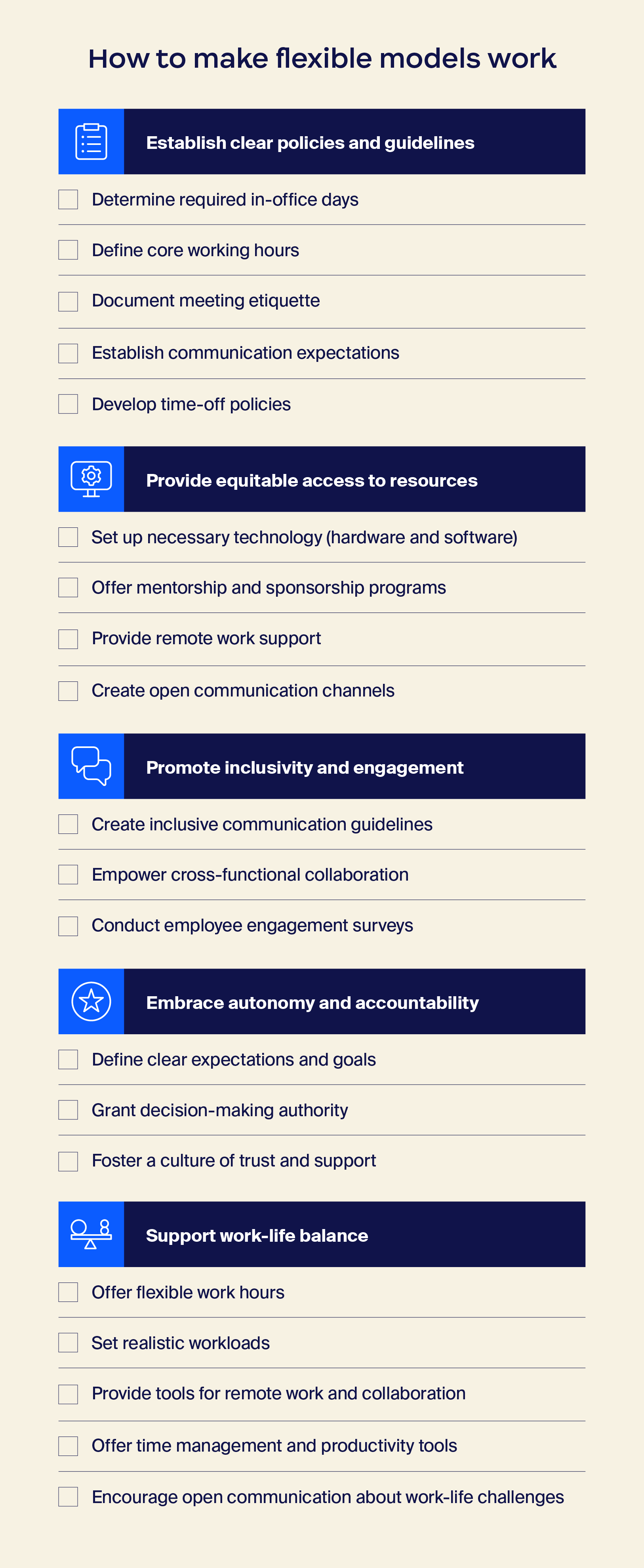
Meet Zoom AI Companion, your new AI assistant!
Boost productivity and team collaboration with Zoom AI Companion, available at no additional cost with eligible paid Zoom plans.
Updated on October 14, 2024
Published on October 14, 2024


The office, as we once knew it, is changing. Just think about how offices used to be compared to now — it’s clear that flexible work models have and will continue to play a vital role in creating healthy, motivated, and efficient teams.
Hybrid work, a dynamic blend of in-office and remote work, has redefined the way we work and live. Over the past few years, it quickly became clear that flexible work models reshape how businesses operate and how employees engage with their jobs. In fact, Zoom’s research on hybrid work found that 64% of organizations operate with a hybrid model.
Let’s explore hybrid work, its different components and types, and how it can help transform your workplace into a healthier, more efficient operation.
Hybrid work is a flexible work arrangement that combines remote and in-office work. Employees split their time between working from home or another remote location and working in a physical office. This approach balances the structure and centralization of the traditional office environment and the flexibility of remote work.
Both employers and employees stand to benefit significantly from hybrid work. For companies, it can lead to increased employee satisfaction, reduced office overhead costs, and access to a wider talent pool. For individuals, hybrid work offers flexibility, improved work-life balance, and the opportunity to work in a more productive environment.
Hybrid work isn’t a one-size-fits-all approach. Companies are and should be experimenting with different models to find what works best for their teams and culture, so much so that 75% of business leaders say their organization will change its workplace model in the next two years towards a more flexible setup. Here are five types of hybrid work to consider:

The flexible hybrid model offers employees maximum autonomy in deciding when to work from the office and when to work remotely. This approach empowers people to tailor their work schedules to their personal preferences, productivity levels, and project requirements.
For example, employees might choose to come into the office on days when they need to collaborate closely with colleagues or attend important meetings. On other days, they may choose to work from home for focused individual work or to enjoy a better work-life balance.
This model requires a high degree of trust between employers and employees, as well as effective communication and collaboration tools to improve productivity.
While this approach can boost employee satisfaction and morale, it’s essential to prepare your company for the hybrid model by establishing clear guidelines and expectations to maintain productivity.
In a fixed hybrid work model, the company determines which days employees are required to be in the office. This approach offers a structured framework for team collaboration and in-person interactions.
For example, a company might mandate that all employees work in the office on Tuesdays and Thursdays, with the rest of the workweek designated as remote work days. This structure can help maintain a sense of team cohesion while providing employees with some flexibility. However, it may not align with some employees’ individual preferences.
When implementing a fixed hybrid model, it’s important to balance the need for in-person collaboration with employee satisfaction. Communicate the rationale behind scheduling decisions and be open with your team about the direction you’re taking. Employee input can often help business leaders refine the balance of hybrid work to find the ideal remote-to-office ratio.
The “as required” hybrid model is driven by project needs. Employees split their time between the office and remote work based on specific project timelines, team collaboration requirements, or company-wide initiatives.
For example, a team working on a high-priority project with tight deadlines might opt for increased in-office collaboration during critical phases. Once the project intensity subsides, team members can return to a more flexible work arrangement. This approach can optimize resource allocation and allow employees to work where they can be most productive.
Effective communication and coordination are important for the success of this model. Clear guidelines for determining in-office requirements and transparent scheduling processes are crucial to avoid misunderstandings and disruptions.
As the name suggests, the office-first hybrid model prioritizes in-person work. Employees are expected to be physically present in the office for most of the workweek. However, organizations often incorporate a few remote work days to offer employees some flexibility and work-life balance.
This model can foster a strong company culture and facilitate face-to-face collaboration. It may also be suitable for roles that require regular in-person interactions with clients or customers. However, for this model to work, employees need to have the necessary tools and support to work effectively from home on their designated remote days.
Overly strict office-first policies can lead to decreased employee satisfaction and difficulties attracting and retaining talent, especially in competitive job markets. You can find the right balance between in-office presence and remote work by working with your team to define expectations, measure the effectiveness of your hybrid model, and then adapt accordingly.
The remote-first hybrid model emphasizes remote work, with the office serving as a secondary workspace for collaboration, team building, or focused work. Employees have the freedom to work primarily from home or another remote location, but they also have the option to utilize the office space when needed.
This model can enhance employee autonomy and work-life balance while fostering a sense of community through occasional in-office gatherings. However, it requires robust digital tools and communication strategies to maintain effective collaboration and knowledge sharing among remote team members.
While the remote-first approach offers flexibility, it’s important to maintain a strong company culture and sense of belonging through regular virtual and in-person team-building activities.
Recent data on hybrid work support the idea that flexible work arrangements offer several advantages for both employees and organizations. By balancing in-office and remote work, businesses can reap significant rewards in terms of employee satisfaction, productivity, and overall company performance.

Flexible work arrangements are a game-changer when it comes to work-life balance. They empower individuals to juggle personal and professional commitments more effectively. This increased control over time management can significantly reduce stress, improve mental health, and enhance overall job satisfaction.
A strong work-life balance is crucial for employee well-being and longevity. When employees feel refreshed and rejuvenated, they are more likely to be engaged, productive, and committed to their roles. And companies that prioritize work-life balance attract and retain top talent, fostering a positive company culture.
When employees feel valued and trusted to manage their work effectively, they’re more likely to remain committed to their organization.
A compelling study from Deloitte highlights the importance of flexibility for younger generations: 75% of Gen Z and millennials working from home or on a hybrid basis would look for a new job altogether if asked to go to the office full-time. This underscores the critical role of flexible work arrangements in attracting and retaining top talent.
Flexible work arrangements can significantly boost employee productivity. By eliminating commuting time and reducing office distractions, employees often find themselves with more focused work hours.
Research supports the notion that flexible work arrangements can positively impact productivity. A study by Owl Labs revealed that over 90% of remote and hybrid employees say they’re just as or more productive in their current working style as they were in the office. This data challenges the traditional perception that in-office work is necessary for productivity.
Flexible work models can lead to substantial cost savings for businesses. Companies can reduce their reliance on physical office space and downsize their real estate, leading to significant reductions in rent, utilities, and maintenance expenses.
A hybrid work model also requires less office equipment and furniture, as employees bring their own devices and supplies when working remotely. This can result in cost savings on computers, monitors, desks, and office supplies. Research by GWA found that the average U.S.-based employer can save $11,000 every year for each remote worker on a two-to-three-day hybrid schedule.
Optimizing your office space and reducing equipment expenditures allows your business to allocate resources to other strategic areas, such as technology investments or employee development.
These days, the very offer of hybrid or remote positions can attract top talent from a wider geographic area rather than being limited to candidates within commuting distance. This increased access to skilled professionals allows companies to find the best fit for their team, regardless of location.
Flexible work options are particularly appealing to a younger workforce that values work-life balance and autonomy. Companies can attract and retain top talent from the coveted millennial and Gen Z demographics. This diversity of perspectives and skills can contribute to a more innovative and dynamic workplace.
Ultimately, the ability to tap into a larger talent pool can give companies a competitive edge in today’s global economy.
Implementing a successful hybrid work model requires careful planning and execution. Several key elements contribute to the effectiveness of a hybrid work arrangement.
Flexibility is a cornerstone of successful hybrid work. Organizations must be adaptable enough to accommodate diverse employee preferences and work styles. This includes being open to trying a range of hybrid models and adjusting these models as needed.
However, flexibility extends beyond work schedules. It encompasses the ability to adapt to changing business needs, technological advancements, and economic conditions. A successful hybrid work strategy involves regularly assessing and refining policies, procedures, and tools to help align with the evolving workplace.
Leveraging the right collaboration platforms can bridge the physical distance between team members. Tools like project management software, instant messaging platforms, and video conferencing solutions can facilitate seamless information sharing, idea exchange, and decision-making.
Alongside unified communications (UC) technology, fostering a strong culture of collaboration can improve hybrid models. Implementing strategies such as virtual team-building activities, regular check-ins, and cross-functional collaboration initiatives can help build trust, strengthen relationships, and enhance overall team performance.
Key tools and platforms for hybrid work include video conferencing software, project management tools, cloud-based document-sharing systems, instant messaging applications, and other flexible collaboration tools.
Investing in robust technology infrastructure helps build a seamless flow of operations. Additionally, companies should prioritize providing employees with the necessary equipment and training to use these tools effectively.
Emerging technologies like artificial intelligence and automation can also enhance the hybrid work experience. For example, AI-powered virtual assistants can provide support, schedule meetings, and compose emails and documents, while automation can streamline routine tasks.
To successfully transition to a hybrid work model, organizations need to prioritize putting together a detailed and feasible plan prior to execution. Several key strategies can help your company maximize the benefits of flexible work while minimizing potential challenges.

These guidelines should outline expectations for both remote and in-office work, including work hours, communication protocols, and performance metrics.
After you’ve established clear expectations, your business can avoid misunderstandings and keep all employees on the same page. Effective communication is an essential prerequisite for a thriving hybrid workplace, so defining communication norms and protocols, such as response times and meeting etiquette, is the name of the game.
All employees, regardless of their location, should have access to the necessary technology, software, and support to perform their jobs effectively. This includes providing high-speed internet access, reliable devices, and ergonomic equipment.
Addressing digital equity is equally important. Companies need to identify and eliminate barriers that prevent employees from fully participating in the hybrid work environment. This includes providing training on technology usage, offering accessible tools for employees with disabilities, and providing remote workers with equal opportunities for professional development and career advancement.
Organizations need to foster a culture of inclusivity where both remote and in-office employees feel valued and connected. Implementing strategies for virtual team-building, such as online social events, can help strengthen relationships and build strong ties.
The key to creating a positive and inclusive hybrid work environment is to encourage open dialogue, recognize employee contributions, and provide opportunities for growth and development.
Give your team the freedom to own their work. When employees have the autonomy to manage their time, tasks, and processes, they often feel more engaged and invested in their roles. This empowers them to think creatively, solve problems independently, and take ownership of their outcomes.
However, autonomy must be balanced with accountability in the form of clear performance expectations, regular check-ins, and outcome-based evaluations. Effective communication and collaboration tools can facilitate accountability and transparency in a hybrid work model.
Prioritize work-life balance for the well-being of employees and the overall success of the hybrid work model. Foster a company culture that encourages employees to set boundaries between work and personal life. This includes providing flexible work arrangements, offering mental health support resources, and promoting time management strategies.
By investing in employee well-being, companies can reduce burnout, increase job satisfaction, and improve overall productivity. A healthy work-life balance is essential for attracting and retaining top talent in today’s competitive job market.
The hybrid work model is still evolving, shaped by ongoing experimentation and changing workforce dynamics. Zoom, alongside Reworked Insights, surveyed more than 600 IT and C-suite leaders and nearly 1,900 knowledge workers to create in-depth research into the future of hybrid and flexible work models. While hybrid is king today, we found that it stands to grow even further — 82% of business leaders say they plan to make their office’s work model more flexible in the next two years.
Demographic preferences play a significant role in shaping the future of hybrid work. Younger generations, such as millennials and Gen Z, tend to prioritize flexibility and work-life balance, making them more likely to favor hybrid or remote work arrangements. However, older generations may have different preferences, with some valuing in-person collaboration and office culture over the novelty and comfort of flexible models.
The approach to implementing hybrid work also varies. Top-down mandates from leadership can provide clear direction but may not fully address employee needs. Bottom-up approaches that involve employee input and feedback can lead to greater buy-in and satisfaction. However, it can also lead to a multitude of voices expressing many different ideas that may not be feasible all at once. A hybrid approach, combining top-down guidance with employee input, often produces the best results.
As technology continues to advance and workplace needs evolve, the hybrid work model will likely become even more sophisticated. We can expect to see further integration of AI and automation, as well as innovative approaches to virtual collaboration and employee experience.
Ultimately, the success of hybrid work will depend on your organization’s ability to adapt to changing circumstances, prioritize employee well-being, and harness the power of technology to create a flexible and productive work environment.
To fully embrace the potential of hybrid work, organizations need a comprehensive platform that brings together all essential communication and collaboration tools.
Zoom Workplace offers an open collaboration platform with AI Companion that empowers teams to connect, collaborate, and innovate, regardless of location. From video meetings and Team Chat to Phone and email, Zoom provides a single platform for seamless communication and productivity.
And this isn’t only relevant to those working in a remote or hybrid model. Zoom’s robust feature set goes beyond the tools on your screen. Products such as Zoom Rooms and Workspace Reservation support every workplace dynamic and bridge that communication gap for hybrid teams, whether the entirety or a portion of the company works remotely.